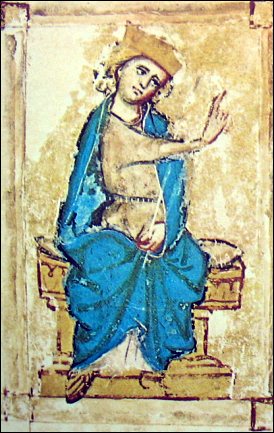Margaret Sambiria facts for kids
Quick facts for kids Margaret Sambiria |
|
|---|---|
 |
|
| Queen consort of Denmark | |
| Tenure | 1252–1259 |
| Born | c. 1230 Germany |
| Died | December 1282 |
| Burial | Doberan Abbey |
| Spouse | Christopher I of Denmark |
| Issue | Eric V of Denmark |
| Father | Sambor II, Duke of Pomerania |
| Mother | Matilda of Mecklenburg |
| Religion | Roman Catholicism |
Margaret Sambiria (born around 1230 – died December 1282) was a powerful queen and leader in Denmark. She became the Queen of Denmark when she married King Christopher I. After her husband died, she became the regent, meaning she ruled the country for her young son, King Eric V. She was regent from 1259 to 1264. Margaret was the first woman in Denmark to officially rule as a regent. She also governed Danish Estonia from 1266 until her death in 1282.
Contents
Life of Margaret Sambiria
Margaret was born in Germany around 1230. Her parents were Sambor II, Duke of Pomerania and Matilda of Mecklenburg.
She had family connections to Denmark through her mother's side. Her grandparents were Henry Borwin II, Lord of Mecklenburg and Lady Kristina from Scania. Kristina was said to be from an important Danish family. Margaret received her name, Margaret, which was not common in her home region then. It was given in honor of her Scandinavian relatives.
Becoming Queen of Denmark
In 1248, Margaret married Prince Christopher. He was the youngest son of Valdemar II of Denmark. In 1252, her husband became the King of Denmark. Margaret was crowned Queen alongside him.
Even as queen, Margaret was interested in politics. During Christopher's rule, there was a big disagreement between the king and Jakob Erlandsen. He was the Archbishop of Lund. The Archbishop wanted the church to be independent from the king's rule. He even wanted to have his own armies. This disagreement led to his arrest. Margaret would later have to deal with this problem when she became regent.
Ruling as Regent
King Christopher I died on May 29, 1259. Some people believed he was poisoned. Their son, Eric V of Denmark, was still a child. So, Margaret became the regent. This meant she would rule Denmark until Eric was old enough, which happened in 1264. This was a very unusual event in Denmark. No other queen had officially held such power before.
As regent, Margaret faced many challenges. The conflict with Archbishop Jakob Erlandsen was still ongoing. She had to release the archbishop to make her own position stronger. But she solved the power struggle by sending him out of the kingdom. The issue of the church's independence was not fully settled until later. However, Margaret continued to talk with the Pope until the matter was resolved. She did this even after her time as regent ended.
Margaret also had to protect her son's right to be king. Her husband's brother, Abel of Denmark, had sons who also claimed the throne. Abel's widow, Matilda of Holstein, supported their claims. Margaret also had to care for the four daughters of another brother-in-law, Eric IV of Denmark. These daughters were Sophia, Ingeborg, Jutta, and Agnes. Eric V's claim to the throne was stronger than the claims of earlier monarchs' descendants.
The conflict with Abel's sons led to wars with the counts of Holstein. In 1261, Margaret and her son Eric V were captured after a battle. But they soon escaped with help from Albert of Brunswick. Margaret could not stop some marriage alliances. Abel's widow, Matilda of Holstein, married Birger Jarl. Eric IV's daughters, Sophia and Ingeborg, married the kings of Norway and Sweden. But Margaret did prevent Eric IV's other daughters, Jutta and Agnes, from similar marriages. She placed them in a convent called St. Agnes' Priory, Roskilde.
In 1263, Margaret wrote to Pope Urban IV. She asked him to allow women to inherit the Danish throne. This was a final effort to stop Abel's family from claiming the throne. If Eric V died without children, one of his sisters could become queen.
During her time, Margaret was known as a smart and capable ruler. Her nicknames, "Sprænghest" (meaning 'Burst-horse') and "Sorte Grete" (meaning 'Black Greta'), show she was strong-willed and full of energy.
Later Life and Legacy
Margaret stopped being regent in 1264. Her son was then old enough to rule. She moved to her own home, Nykøbing Slot on Falster, and had her own court. She still played a part in Danish politics. She kept some influence over how Denmark was run.
In 1266, her son, the king, gave her control of Danish Estonia. She became the ruling countess of that area for life. She managed Estonia's affairs from Denmark until she died.
In 1270, she helped start and gave money to the Abbey of the Holy Cross in Rostock.
Margaret died in December 1282. She was buried in the church of the Cistercian Doberan Abbey in Germany.
Margaret's Children
Margaret and Christopher had three children:
- Matilda (died between 1299 and 1300), who married Albert III, Margrave of Brandenburg-Salzwedel.
- Margaret (died 1306), who married Count John II of Holstein-Kiel.
- Eric V of Denmark (1249–1286), who became King of Denmark.
Related reading
- Anne J. Duggan, ed (2002) Queens and Queenship in Medieval Europe (Boydell Press) ISBN: 9780851158815
- John Carmi Parsons, ed (2016) Medieval Queenship (Springer Publishing Company) ISBN: 9781137088598
|
Margaret Sambiria
House of Sobiesław
Born: 1230 Died: 1 December 1282 |
||
| Danish royalty | ||
|---|---|---|
| Preceded by Matilda of Holstein |
Queen consort of Denmark 1252–1259 |
Succeeded by Agnes of Brandenburg |
See also
 In Spanish: Margarita Sambiria para niños
In Spanish: Margarita Sambiria para niños

